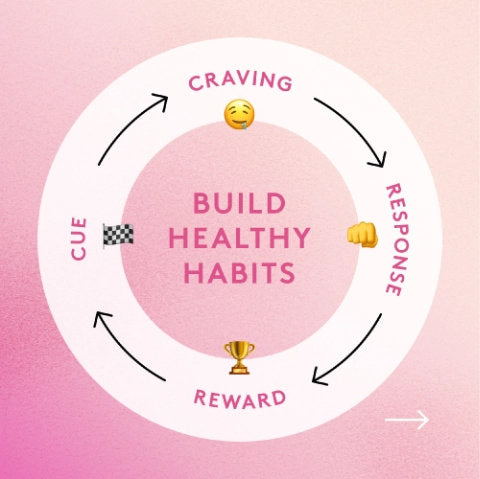If there’s one thing we have learnt over the years in the nutrition and fitness industry, it’s that there is simply no such thing as a one-size-fits-all diet, or nutritional approach to fat loss or muscle gain.
If we had the option to take a magic pill that could transform our body into our dream aesthetic and health, most people would take it without hesitation.
Though, when it comes to putting in the hard work, consistency, and determination required to actually achieve our goals, we typically continue seeking the easiest option, or the option that’s worked for someone else we know.
There are countless diets that you could follow, but all diets are useless if you can’t adhere to them. Therefore, it’s important to find something that works best for you personally - something that fits your preferences, lifestyle, and personal needs.
This may be counting macros, it may be keto, or it may be something entirely different, such as building your own positive diet and lifestyle habits and creating your own plan.
It’s key to trial and error your approach - if something isn’t working for you, change it. If something needs adjusting, tweak it!
You have probably heard about the macro and keto diet, two popular methods of eating that have grown in popularity over the years. Some claim them to be either the answer to weight loss, or the reason for health issues.
This article compares these two diets, the benefits and downfalls of each of them, and what you need to think about before introducing certain dietary restrictions into your life!
Firstly, let’s unpack what exactly these two diets are and what they entail.
Macro Diet
The macro diet is probably the best of the bunch when it comes to fad diets and nutrition programs. This diet essentially requires you to count your macros (macronutrients) - protein, carbohydrates, and fat.
This is a more complex way of counting calories, which is actually the principle of fat loss.
So, this diet is one of the few ones that’s actually got some very robust science backing it, as calories pretty much control our bodyweight. Though, the difference being is that you’re counting your macronutrients.
This would cause you to have to narrow down your dietary choices to best fit your target macros, as you would have a certain amount of protein, carbohydrates, and fat to eat each day to fulfil your needs.
Not only would you be eating within your daily calorie goal, but you would also eat the optimal amount of macronutrients too, which would offer further support for your health and performance.
Pros
- It’s based on science - the principle of weight management - calories control body weight
- It still allows for some flexibility, provided you’re hitting your target macros each day
- When followed correctly, it will provide excellent results
- It doesn’t require you to cut out or demonise any food groups
Cons
- It is a lot of work counting calories, and macros is one step further - it may be difficult and time consuming
- It may allow too much flexibility, as there is no requirement to track or measure micronutrient intake
- It can be difficult to make adjustments without a nutritionist or coach to help you
- Not suitable for those who have a poor relationship with food or have suffered from eating disorders or disordered eating
Keto Diet
The ketogenic (keto) diet involves following a high fat and low-carbohydrate diet. Carbohydrates will typically make up only 10-15% of your total daily calories, with protein being around 20-25%, and fat making up the rest.
Keto allegedly changes the way our body produces and uses energy. As carbohydrate intake is so low (which is usually our primary source of energy), our glycogen stores drop and our body will prefer to use fat instead, as it is more readily available. They call this being “fat adapted”.
Pros
- It has simple and clear guidelines around food
- May help someone reduce their sugar intake
- May provide some health benefits, though the research is still not conclusive
- It may have additional benefits to those suffering from certain health conditions, such as celiac disease or diabetes
Cons
- The keto diet is a major lifestyle commitment. While the guidelines are clear, it doesn’t allow for much flexibility and may be difficult to sustain long term.
- You will probably experience “keto flu”, which happens upon transitioning to keto (lethargy, headaches, brain fog, etc.)
- Testing your ketone levels would require a testing kit
- Keto wouldn’t be suitable for many people, particularly most athletes or those who have a history of disordered eating
Macro Vs Keto: Which is Better?
As we have already established, it would be difficult to determine which diet is better, as this would largely be down to the individual. While keto has worked well for many people, it hasn’t been the best dietary choice for many others.
We can say the same thing for counting macros, or even just calories, it’s just not suitable for everyone.
However, if we were to compare these two diets simply on the science behind them both, counting macros would likely elicit better, healthier results as opposed to keto.
This is because we base the macro diet on the principle that calories determine body weight. This is also a more robust, restricted way of simply reducing food intake and making better dietary choices.
While this is a simple concept for many, some of us would prefer the guidelines and numbers to follow, which the macro diet would provide.
Other Diets
While keto and macro counting are two popular diets, especially for fat loss, there are also some diets that are worthy of a special mention.
The Zone Diet
The zone diet, a diet developed by a doctor, is a systematic diet plan where the primary goal is to remain in “the zone”. This diet encourages you to eat a certain amount of protein, carbohydrates, and fat - much like counting macros.
Though this involves more structure and rigidity. Additionally, it is based on the claim that eating “in the zone” will reduce inflammation in the body and provide many more health benefits.
Calories must be consumed in a ratio of 40% carbohydrates, 30% fat, and 30% protein - these macronutrients are classified into “blocks” which allows the control of total calories.
You must weigh and measure foods precisely, and restrict many food groups such as refined carbohydrates, starchy vegetables, processed grains, and “high-sugar” fruit.
Pros
- Once again, this diet is based on a calorie-counting principle, so would essentially result in body weight changes when followed correctly
- Promotes more of a focus on nutrient-dense foods
- Helps to educate around adequate portion sizes
Cons
- The zone diet can be very confusing, especially at first, due to the “block” system
- Lacks scientific research, not shown to be massively effective or healthy
- Can be very restrictive for those who enjoy eating grains and fruit
- Can be difficult to explain in social situations
Flexible Dieting
Flexible diet is a diet where no food is off limits. Instead, it simply requires moderation. This diet is though to be beneficial for those who find diets easier to follow without rules and restrictions.
Many people who choose flexible dieting will track their food intake to ensure they are consuming enough of each nutrient.
Pros
- Flexible dieting provides a lot of insight into how much you’re eating, which makes it easier to make adjustments based on your goals and results
- It is very flexible, meaning that you can bend it to fit your lifestyle and needs while still getting results
- It can be very sustainable and doesn’t require restriction
Cons
- Requires a food scale for measuring and weighing food intake, which can feel tedious
- Not suitable for those who want more clear-cut rules and boundaries around food
- Can be easy to overeat highly processed foods as it’s essentially justified
Paleo
The Paleo diet, also known as the primal diet, is based on the idea that humans have adapted to eat particular foods in order to stay healthy - so we should eat like our ancestors.
It involves eating meat, and often all parts of the animal, as well as fish, fruits, vegetables, nuts and seeds, and about any food that could be obtained by hunting and gathering.
This means that it does not allow for starchy carbohydrates such as potatoes and rice, or dairy and legumes.
Pros
- The guidelines are fairly clear on what to eat and what not to eat
- Focuses heavily on the consumption of nutrient-dense, high-quality foods
- Could be effective for promoting certain health markers
Cons
- May be too restrictive for most people, thus affecting long-term sustainability
- No calorie or macronutrient guidelines, so may not make a difference in body composition
- Confusion around what foods we categorize as Paleo
The Best Diet for You
As you have read, there are many diets which promote different results, methods of eating, restrictions, or non-restrictions.
While there are some clear pros and cons to many of these diets, the best diet for you ultimately comes down to your personal preferences and needs.
We have established that to lose fat or gain muscle, or make any changes to your body composition, calories must be considered. This could be counting calories, or simply practicing portion control and making adjustments to diet and lifestyle habits.
The rigidity of your diet depends on how well you can adhere to rules and boundaries. The bottom line is that the perfect diet is simply the one you can adhere to!
The best diet includes foods you enjoy, can be followed during tough times, allows you to perform at your best (physically and mentally), keeps your body and soul thriving, and has a suitable amount of structure and flexibility for your personality and lifestyle.
Building Better Nutrition Habits
One of the biggest misconceptions in the nutrition and fitness industry is that you must follow a diet in order to lose weight. This is simply not true.
Diets rarely work, or if they do, they don’t work long-term. A better approach is to make positive changes to the diet you already have, which would enable you to sustain it long term.
Simply introducing some positive nutrition habits into your lifestyle could make a vast difference. For example:
- Eating more vegetables
- Slightly reducing highly processed foods
- Drinking more water
- Consuming more protein
- Focusing on plenty of fruits, vegetables, and whole foods
- Exercising and finding an activity you enjoy doing regularly
These behaviors can help you achieve your goals if you find a protocol that works best for you. Implement a couple of habits a week and build up from there, and don’t be afraid to make adjustments if something isn’t working for you!
Take-Home Message
There are hundreds of diets available for you to choose from, though if you take anything away from this article, it’s that none of them will work unless you adhere to them.
Unfortunately, there is no magic pill which will give us our dream body, we must put the work in. But before we do that, we must determine an approach that works best for our lifestyle and personality.
This may be the keto diet, it may be counting macros, or it may be simply making changes to your current diet and lifestyle (what we would recommend!).
One thing for certain is that action is required to get results!











